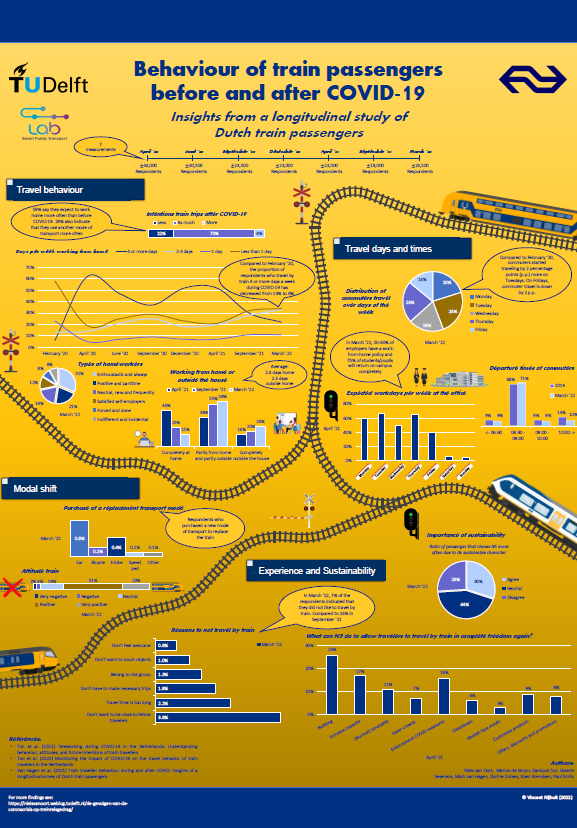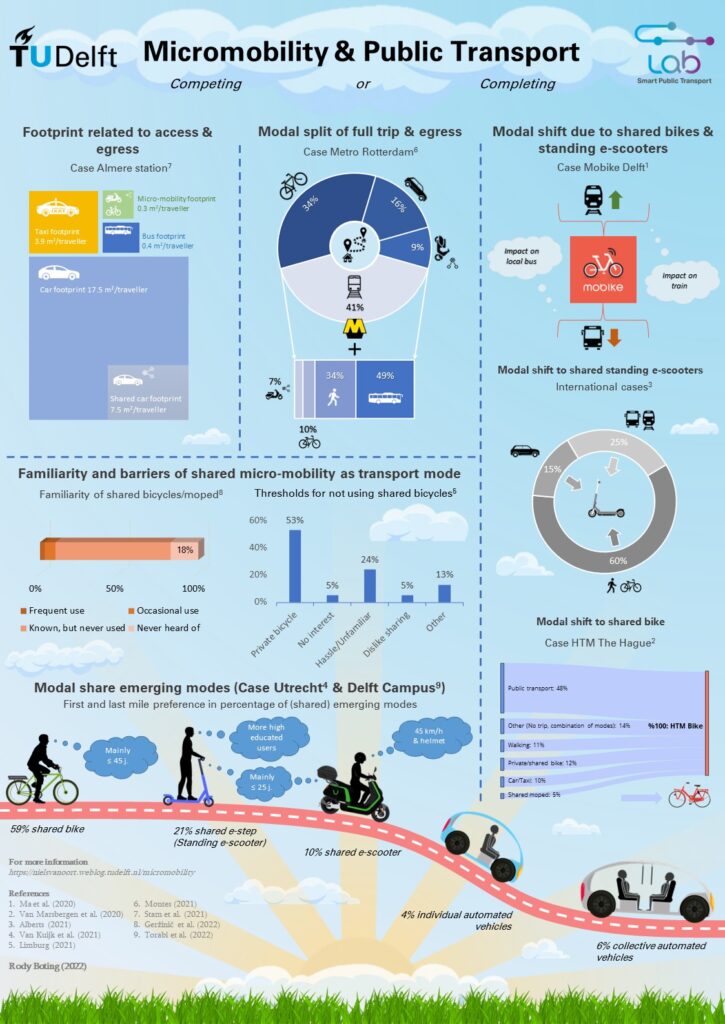Niels van Oort
CVS congres 2022
Op het CVS congres 2022 waren de volgende presentaties en papers vanuit het Smart Public Transport Lab:
Een onderzoeksagenda voor sociaal inclusieve mobiliteit in de Vervoerregio Amsterdam, Matthew Bruno, Niels van Oort, Suzanne Kieft: Paper en presentatie(NL) en presentation(English)
De invloed van comfort en veiligheidsgevoel op stationskeuze voor fietsers, Anne Barneveld, Raymond Huisman, Niels van Oort: Paper en presentatie
Een wijkhub voor iedereen? Inzichten in de behoefte aan hubfaciliteiten en deelmobiliteit voor verschillende bevolkingsgroepen, Jarco Vianen, Niels van Oort, Minze Walvius: Paper en presentatie
Covid impacts on train travel behaviour
Delft University of Technology and the Dutch railways (NS) started a joint, longitudinal research in April 2020 on Covid impacts on train passenger behaviour. During the pandemic, 7 surveys in different stages (15,000-45,000 participants each) were held to learn about the impacts and expectations. The main results are presented in an infographic.

Find the high resolution infographic HERE. Also available in DUTCH
Find the detailed results in these scientific papers:
Transportion research-Part A: Teleworking during COVID-19 in the Netherlands: Understanding behaviour, attitudes, and future intentions of train travellers
Bivec Transport Days: Train traveller behaviour during and after Covid: insights of a
longitudinal survey of Dutch train passengers
Transport Research Procedia: Monitoring the impact of COVID-19 on the travel behavior of train
travelers in the Netherlands
Find other output such as reports, presentations and media articles
Micromobility and public transport
Following technological and societal developments, new modes and services arrive in our cities. Micromobility solutions, such as shared (e-)bikes and –scooters, are adding new opportunities for individuals, but what their (potential) contribution is to societal objectives such as sustainability, land use and inclusiveness, is not yet known. In order to gain this knowledge and optimize the mobility mix, the Smart Public Transport Lab investigates the demand and supply impacts and interaction of micromobility, including the interaction with public transport. In this infographic the main, recent results of the ongoing research are summarized.

Find more results and details in the related papers and theses:
1. Ma et al. (2020): Bike-sharing systems’ impact on modal shift: A case study in Delft, the Netherlands
2. Van Marsbergen et al. (2022): Exploring the role of bicycle sharing programs in relation to urban transit
3. Alberts (2021): Standing e-scooters, what to expect: micro-mobility with micro effects?
4. Van Kuijk et al. (2022): Preferences for shared modes of local public transport users in the last mile
5. Limburg (2021): Potential for sustainable mode usage amongst car users in mid-sized cities
6. Montes et al. (2023): Studying mode choice in multimodal networks including shared modes
7. Stam et al. (2021): Travellers’ preferences towards existing and emerging means of first/last mile transport: a case study for the Almere centrum railway station in the Netherlands
8. Geržinič et al. (2022): Potential of on-demand services for urban travel
9. Torabi et al. (2022): Passengers preferences for using emerging modes as first/last mile transport to and from a multimodal hub case study Delft Campus railway station
European Transport Conference 2022, Milano
The European Transport Conference (ETC) is taking place this week, September 7-9 2022 in Milano, Italy.
The following Smart PT Lab contributions will be presented:
Change in train travelling behaviour during and after Covid-19 due to anxiety (Presentation and research report)
G.B. Hafsteinsdottir, R. van der Knaap, N. van Oort, M. de Bruyn, M. van Hagen.
Shared micromobility and public transport integration. A mode choice study using stated
preference data (Presentation and research report)
A. Montes Rojas, N. Geržinic, W. Veeneman, N. van Oort, S. Hoogendoorn,.
Understanding the whole station choice concept by cyclists (Presentation and research report)
A Barneveld, R Huisman, N. van Oort.
The full program can be found here:
The future of public transport
Every year in the advanced public transport course, students write an essay on the future of public transport. Passenger association ROVER selects the best one according to the passengers’ perspective. The authors of the winning essay are invited to record a podcast with Geert Kloppenburg in his Metroplitan Podcast series.
2022
Find the winning essay of Hugo Odijk and Tim de Ridder: HERE
Listen to their podcast: HERE
2021
Find the winning essay of Monica van Luven and Stavros Xanthopoulos: HERE
Listen to their podcast: HERE
Student views and research results
Learn more about the views and the research results of our (former) MSc./BSc students in multiple media appearances:
Booklet with all student research stories until 2024 in OV magazine (in Dutch), including student reflections and vision of Jan van Selm.
Janine Grauss, Jorn vd Steen en Yvar de Waaij: Podcast Toekomst van OV en deelmobiliteit op het platteland
Emma Zadeits en Luke Tros: Onderzoeksgroep duurzame mobiliteit groeit bij TU Delft Delft
Tim de Ridder and Hugo Odijk: Podcast Toekomst van het openbaar vervoer
Simone Hoskam: Story of Science video, bicycle+train combination
Monica Van Luven and Stavros Xanthopoulos: Podcast, shared mobility
Tessa Leferink and Joeri van Mil: Blog bicycle+transit combination
Jarco Vianen and Iris van Gerrevink: Verkeersnet TV (in Dutch), mobility hubs
Lara Witte: OV Pro (in Dutch), Covid impacts on public transport
Lucia Bloemendal: OV Magazine (in Dutch), impacts of Covid on mobility
Also check our regular one-pagers in OV Magazine about our research.
HUBgebruiker als uitgangspunt voor ontwerp
Mobiliteitshubs lijken het nieuwste wapen in de strijd om mobiliteit duurzamer en aangenamer te maken. Maar voor wie maken we die hubs?
Lees het hele onderzoek van Jarco Vianen HIER
EenVandaag over structurele gedragsveranderingen treinreizigers na Corona
Bijdrage aan EenVandaag reportage over de toekomst van OV, met resultaten uit ons Corona onderzoek TU Delft ism NS over structurele gedragsveranderingen. Ook pleidooi voor bredere blik op de waarde van OV, met oa aandacht voor duurzaamheid en inclusiviteit:
Meer inzichten uit ons Corona onderzoek: HIER
Smart Public Transport Lab
Wij geloven dat het openbaar vervoer een cruciale rol speelt in de ontwikkeling van aantrekkelijke, bereikbare en duurzame steden en regio’s. Het Smart Public Transport Lab van de TU Delft ontwikkelt nieuwe oplossingen en methoden voor de planning, exploitatie en het beheer van openbaar vervoer.
In het Smart Public Transport Lab zijn we gepassioneerd over het uitvoeren van wetenschappelijk onderzoek van hoog niveau met een praktische relevantie en impactvolle resultaten. Welkom aan boord!
Podcast Mobility Innovators: Human-centered design for Smart Public Transport
Technology and New mobility are reshaping urban transportation in cities. Human-centric design is key to the quality of life in cities, putting people at the heart of urban transport planning. All stakeholders, including academia, will play a key role to reshape the future of mobility.
Listen to the podcast of Mobility Innovators with Niels van Oort:
04:00 Service reliability in public transport
07:40 About Smart Public Transport Lab at Delft University
14:00 How to run LRT system in the cities efficiently
20:20 Digital Inequality in Transport Services
28:50 Tesla predication on Self Driving Vehicles
34:50 MaaS from the passengers’ perspective
38:30 First & Last miles connectivity
44:54 Use of Big Data to improve services
49:05 Role of academia in the new world
Find more details about the discussed topics here:
Digital inequality (literature review paper)
Service reliability (podcast and papers)
5E model of wider impacts of public transport (book chapter 6, page 112-)
